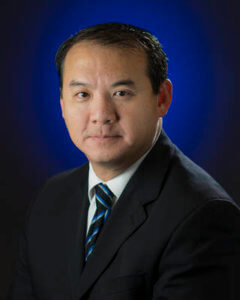
Portrait of Steve Shih on Wednesday, Dec. 6, 2017 at NASA Headquarters in Washington, DC. Photo Credit: (NASA/Joel Kowsky)
By Dan Gephart, July 30, 2019
Anyone who has ever attended a mediocre leadership training has surely heard the story of the Janitor and the President. Per the legend, President John F. Kennedy was touring NASA in the agency’s early days when he came upon a man sweeping the floor. The president asked him what he was doing. The janitor replied: “Mr. President, I am putting a man on the moon.”
The Janitor and the President is often shared as an example of how a great leader gets buy-in to organizational mission. I imagine that most of you, like me, recognize it as fiction more than reality. The story has more holes than the colander shelf at Bed Bath and Beyond.
What I don’t doubt, however, is the space agency’s amazing success at making all facets of the organization feel a part of the mission, especially when it comes to EEO/Diversity.
Today we pick up our conversation from earlier this month with Steve Shih, NASA’s Associate Administrator of Diversity and Equal Opportunity. (See Part I of the interview here.) Shih and I didn’t discuss the Janitor, President Kennedy, or the Moon Landing. (Happy 50th anniversary NASA!). But Shih did mention the Low-Boom Flight Demonstration (a supersonic flight with technology that reduces the loudness of a sonic boom), the International Space Station, the Parker Solar Probe, and Mars InSight Lander. All these projects are collaborations with academic, commercial and international partners. And they all are projects taken with Diversity & Inclusion (D&I) and EEO in mind, according to Shih.
DG: One of NASA’s most publicized goals is the return to the Moon by 2024. How is EEO part of that mission?
SS: D&I and EEO is an enabler for this exciting mission, including in our emphasis on the equitable and inclusive contributions of the entire diversity of NASA’s organizations and workforce, and our historical and inspirational plan to not only land Americans but to also land the first woman on the moon.
Every aspect of this mission from the rocket to the European Service Module, to the Gateway lunar outpost, to the Lunar Lander – will involve NASA’s collaboration and partnership with other sectors and other countries, and the services of our diverse Astronaut corps.
DG: You’ve worked for several agencies. How does agency culture define EEO’s approach, and how would someone go about changing that culture?
SS: Different agencies have different approaches and different strategic emphases on D&I and EEO. As leaders and practitioners in federal agencies, we have a responsibility to help provide leadership on shaping a culture of inclusiveness, fairness, and employee engagement … and to align culture, policies, programs, and personnel management towards mission accomplishment, both in achieving immediate priorities as well as sustainment of effective and efficient services to the American people.
At NASA, our leaders and workforce understand the importance of D&I and EEO for mission accomplishment. Our past and most current work provide abundant examples of accomplishments that required inclusive participation and teamwork across NASA and with external partners in other sectors and countries.
DG: How does an EEO professional create an environment where employees take EEO training seriously?
SS: Practitioners can best generate support and commitment for D&I and EEO including training, by ensuring D&I and EEO initiatives align to mission and offer value for agencies, organizations, and workforces. A value-added approach fosters an intrinsic motivation by individuals to support training or other programs, whereas a compliance approach (e.g., mandatory requirement) rests on an extrinsic motivation that not only may fail to create genuine commitment, but sometimes can cause resistance and resentment.
DG: In light of the #MeToo movement, what are some things agencies should know about harassment?
SS: Across our country, we’ve learned a great deal about contributing conditions and risk factors for harassment. Research informs us harassers often possess the following qualities: lack of empathy, belief in traditional gender roles, and a tendency toward dominance/authoritarianism, particularly involving power imbalances between individuals.
We know more about factors that increase the risk of workplace harassment, including:
- Homogeneous workforces
- Workplaces with cultures or social norms that permit or excuse harassment
- Existence of cultural and language differences
- Coarsened social discourse outside the workplace
- Workforces with many young workers
- Workforces with “high value” or “superstar” employees
- Workplaces that rely on customer service or client satisfaction
- Workplaces where work is monotonous or consists of low-intensity tasks
- Isolated workspaces
- Workplaces with cultures that tolerate or encourage alcohol consumption
- Decentralized workplaces
The EEOC has consistently provided outstanding leadership on the issue of harassment. Most recently, EEOC led a task force to study harassment and subsequently issued a June 2016 Report of the Co-Chairs of the Select Task Force on the Study of Harassment in the Workplace, and resources for employers to proactively prevent and to promptly correct harassment. The EEOC has issued many guidance documents on harassment. Additionally, EEOC’s “Model Equal Employment Opportunity (EEO) Program” Management Directive 715is extremely helpful for agencies to establish and maintain strong policies and programs for EEO, including for anti-harassment.

